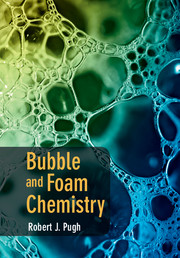Book contents
- Frontmatter
- Contents
- Preface
- Acknowledgments
- List of symbols
- 1 Basic principles and concepts
- 2 The nature and properties of foaming surfactants
- 3 Soap bubbles and thin films
- 4 Processes in foaming
- 5 Generation of bubbles and foams
- 6 Coalescence of bubbles in surfactant solutions
- 7 The stability/instability of bubbles and foams
- 8 Particle-stabilized foams
- 9 Foaming in non-aqueous liquids
- 10 Antifoaming and defoaming
- 11 Bubble size measurements and foam test methods
- 12 Bubble and foam chemistry - new areas of foam research
- Index
- References
11 - Bubble size measurements and foam test methods
Published online by Cambridge University Press: 05 September 2016
- Frontmatter
- Contents
- Preface
- Acknowledgments
- List of symbols
- 1 Basic principles and concepts
- 2 The nature and properties of foaming surfactants
- 3 Soap bubbles and thin films
- 4 Processes in foaming
- 5 Generation of bubbles and foams
- 6 Coalescence of bubbles in surfactant solutions
- 7 The stability/instability of bubbles and foams
- 8 Particle-stabilized foams
- 9 Foaming in non-aqueous liquids
- 10 Antifoaming and defoaming
- 11 Bubble size measurements and foam test methods
- 12 Bubble and foam chemistry - new areas of foam research
- Index
- References
Summary
“…When you can measure what you are speaking about, and express it in numbers, you know something about it, but when you cannot express it in numbers, your knowledge is of a meager and unsatisfactory kind….”
Lord Kelvin, Electrical Units of Measurements, 3 May, 1883. (zapatopi.net/kelvin/quotes).Introduction
Several non-intrusive analytical techniques have been used to provide information on bubble size distributions, gas fraction, texture and general characteristics of foams. Some of these are relatively simple optical methods, but with the application of image and video analysis, the changes in bubble size and texture of 2D foams can be fairly easily studied during ageing. This information can be useful, but since the rate of deterioration of a wet foam depends on the kinetics of coalescence, drainage and gas diffusion, it is sometimes difficult to separate these events and to resolve the main destabilization mechanism. Bisperink and coworkers (1) reviewed how the variation in 2D bubble size distribution in aging foams may be related to drainage, coalescence and the disproportionation process. Although microscopy can be conveniently used to study 2D foams, more complex techniques based on tomography have been applied to probe the interior and to measure bubble size distribution on 3D foams. The processing of the data usually involves three steps: image acquisition, image processing and data extraction. 3D imaging techniques such as nuclear magnetic resonance imaging (NMRI) or X-ray computerized tomography can be used to develop a scale model in a computer memory. Based on these models the relationship between physical properties and the structure of solid foams can be established. UV, NMR and ultrasonic reflection methods have also been used, but overall it is still difficult to characterize bubble size and liquid fraction in real 3D foams, and hence most investigations are carried on quasi-2D foams.
Although wet foams are unstable, the kinetics of breakdown can range from seconds to weeks, and this has resulted in the development of many different types of test methods for measuring foam stability. Overall, stability tests may be broadly classified as (a) dynamic tests, which measure the height or volume of the foam in a state of dynamic equilibrium between formation and decay, and (b) static tests, in which the rate of foam formation is zero (the gas flow into the liquid is eliminated) and the foam is allowed to collapse.
- Type
- Chapter
- Information
- Bubble and Foam Chemistry , pp. 372 - 404Publisher: Cambridge University PressPrint publication year: 2016
References
- 1
- Cited by



